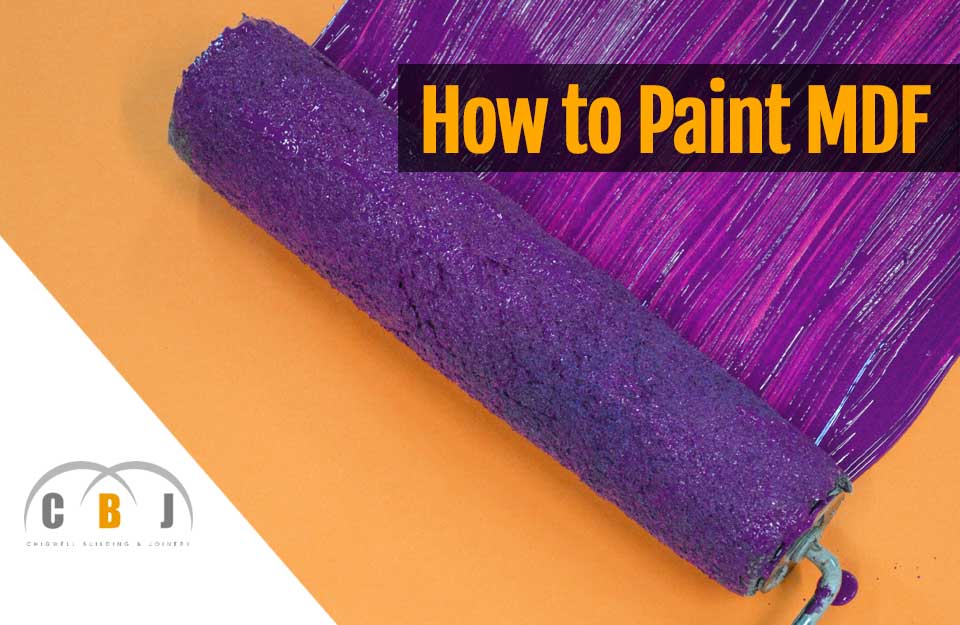
How to Paint MDF
Author Chigwell Building & Joinery
Date 01/06/22
Nowadays, MDF is a commonly used material for furniture as well as for various construction projects.
This affordable engineered wood material is very versatile, easy to cut and quite durable too.
Thanks to its smooth surface it can also be painted, and that is just what we will be focusing on here.
Painting MDF calls for a good understanding of the material itself, as well as being aware of certain things to make sure that it produces a good looking finish.
Table of Contents
- Can You Paint MDF?
- Pros & Cons of MDF
- Tools & Materials
- Surface Preparation
- Edge Preparation
- Apply Primer
- Apply Paint
- Frequently Asked Questions
- Conclusion
Can You Paint MDF?
Image credit: Pexels
Often the answer to this question is debatable.
MDF can be painted as long as you are careful how to go about it.
MDF is basically made up of a combination of sawdust and resins.
These are bonded together by means of a process involving very high heat and pressure.
MDF is free of knots, rings and grains which are present in real wood.
Consequently it has a smooth surface which can be painted.
However one needs to be extra careful when it comes to the uniformity that can be achieved when painting MDF.
This is because the edges are considerably porous, and so they require more prep to achieve the best results.
Moreover, since MDF is porous it is not a good idea to use water-based products for the first coating.
Any painting project requires some preparation to ensure the best results.
And one needs to make sure that the right paint is used, coupled up with the right approach.
MDF has a 150 grit on the front and back, whereas its edges are more rough and porous.
So it is crucial to ensure that they are properly prepared in order to create a uniform substrate which is ideal for the paint to be applied upon.
We shall be tackling this in more detail hereunder.
Pros & Cons of MDF
Image credit: Pexels
Pros:
- Since MDF does not have a visible grain, it has a uniform appearance.
- MDF is made from very small fibres which also contribute to a smooth surface which is good for painting.
- MDF is not that volatile to movement in relation to a natural wood surface, and this helps the paint from cracking.
Cons:
- Since there is no grain, it is not possible to gain a texture that can be achieved when wood is stained.
- MDF is considerably porous and so it is best to opt for oil-based paint rather than water-based.
- It is best to prime and seal it first.
- When sanding and sawing MDF prior to painting it, a lot of dust will result and so it is important to be careful and wear suitable safety gear.
Tools & Materials
Image credit: Pixabay
The following are some tools and materials you will need to prepare MDF for painting, as well as to proceed with painting it.
- Sandpaper or electric sander
- Radiator brush
- Radiator roller
- Paint
- Paintbrush
- Sealer
- Face mask
- Eye protection
- Drop cloths
Surface Preparation
The first step is to make sure that you carry out preparation of the surface properly.
This includes sanding, cleaning and sealing.
Sand down the MDF surface using a light key sandpaper, such as 120 grit.
Sanding will improve the adhesion of the MDF to paint.
The MDF boards will have dust, dirt or other grime on them, and so it is important to clean them before moving onto a second coating of priming and subsequently, painting.
You can use a universal cleaner which can work as a degreaser as well as a cleaner.
This can be wiped down with a cloth, so as to properly clean the surface of the MDF boards.
Edge Preparation
Image credit: Pixabay
It is very important to prepare the edges properly, especially since as mentioned earlier, MDF boards’ edges are rougher and more porous.
Hence they will absorb more moisture than the back or the front of the boards.
Preparing the edges well also ensures that they will be sealed and better able to accept the paint in a way that will better match the smooth surface of the MDF.
Prior to sealing, it is important to sand them by using a 120 grit sandpaper.
Make sure to wear protective goggles and a mask while doing so.
When the edges have been sanded, apply prime the MDF so as to seal them.
This is an important procedure before painting MDF boards.
Once the primer has been given enough time to dry, sand down the edges again.
If the edges are going to be visible, you will want to keep them as smooth as possible.
So, if there are any parts which need to be smoothed out, you may wish to apply some wood filler and rub it down.
Alternatively, you may wish to apply some MDF edging tape.
Apply Primer
Apply a second coat of primer, while making sure you apply it as evenly as you can.
This will be the final base before the painting and so a smooth result is important.
It is best to use a solvent-based primer.
This is because a water-based one might cause the wood fibres to swell, and as a result the surface might appear to have a raised grain even though you sanded it.
The primer can be applied using a roller, a brush or a spray gun, depending on your preferences and the type of project.
Apply Paint
Image credit: Pexels
Painting can be carried out by means of a mini roller or a paintbrush, depending on what you prefer.
A 4 inch roller is generally the best option for most MDF painting jobs.
A foam roller will give a smooth finish, whereas a short pile roller will add some texture to the coating.
On the other hand, if you are painting MDF with detail it is better to use a 1 or 2 inch brush so as to attain a better finish and a thin, even coat.
Allow the first coating of paint to dry completely.
Generally it is better to apply a second coating of paint so that the MDF has a good paint film.
Considering that MDF is porous, you may require more paint than you thought was necessary.
Hence, at least two coatings of paint are necessary in most cases.
You may also need to apply a third coating, especially to the edges.
If the paint looks a bit patchy across the board, this is a sign that another coating of paint is required to achieve a better result.
It is also a good idea to lightly sand between each coating, and wipe down the boards every time so as to remove the dust.
Apply Sealant
Applying a sealant is optional, however it is recommended especially if the MDF will be subjected to heavy traffic or exposed to scuffs.
Sealing will help to preserve the finish, as well as add sheen to the MDF.
Frequently Asked Questions
Q: Is MDF Waterproof Once Painted?
Painting MDF does not mean that it will make it waterproof.
However, since you will be applying a film on the surface, it will help to considerably reduce water damage as it will be better able to resist moisture.
In order to fully waterproof MDF you will need to paint it with a dedicated water-repellant.
This is recommended in case the MDF is going to be outdoors, for example.
Q: Is painted MDF Mould Resistant?
Since painting provides additional water resistant to MDF, it can help to prevent it from remaining damp when exposed to water.
Hence, it could prevent mould from emerging.
Painting MDF is thus highly recommended if the MDF furnishings will be placed in rooms that are prone to high levels of moisture, such as bathrooms and garages.
Q: Can You Paint MDF with a Primer?
Priming MDF is optional.
You can paint MDF without having applied a primer before, however results will not be as good as they would be if primer were applied first.
This is because the MDF will absorb the paint much more quickly, and so you will end up using more paint.
Applying primer before painting can lead to smoother and better results.
Q: Is It Safe to Cut MDF?
MDF is made up of a mixture of dust, fibres and glues.
As a result, when it is cut, these will become airborne.
Should they be inhaled, they could be harmful.
Therefore, when sanding or cutting MDF it is very important that you wear a mask and eye protection to safeguard yourself.
Q: Is Oil Based or Water Based Paint Best for MDF?
Both oil based and water based paint can be used for MDF.
And as with anything else they have their respective pros and cons.
Oil based paint is considered to be more suitable than water based paint for MDF.
This is because oil based paint can lead to a higher quality finish, more sheen and better durability.
Conversely, water based paints dry more quickly and contain less VOCs. They are also easier to use and to clean up than oil based paints.
Conclusion
Making sure that you follow the various steps mentioned to properly prepare the MDF prior to painting will help you to attain a better result.


